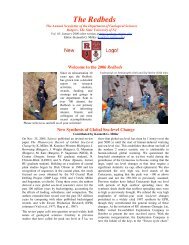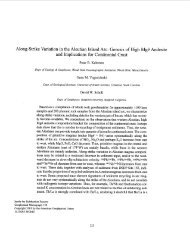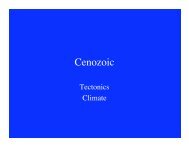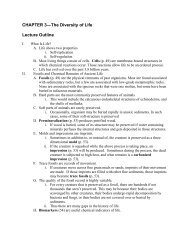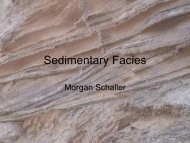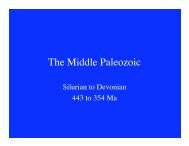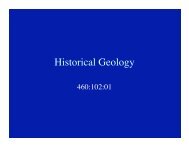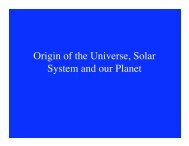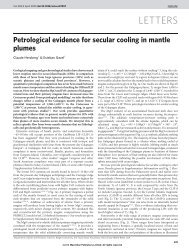The Marine Realm
The Marine Realm
The Marine Realm
You also want an ePaper? Increase the reach of your titles
YUMPU automatically turns print PDFs into web optimized ePapers that Google loves.
Chapter 4<br />
Environments<br />
and Life
What is your current classification?<br />
A. Freshman<br />
B. Sophomore<br />
C. Junior<br />
D. Senior
Guiding Questions<br />
• What factors determine the ecological<br />
niches of species, and by what means do<br />
species obtain nutrition?<br />
• What factors govern the geographic<br />
distribution of species?<br />
• What factors govern the distribution of<br />
aquatic life?
Environmental Differences<br />
• Tropical vs Polar - Terrestrial and <strong>Marine</strong><br />
• Low vs High Elevation<br />
• Shallow vs Deep<br />
• Wet vs Dry
Hypsometric Curve<br />
• Curve showing the proportions of the<br />
Earth’s surface above and below sea level
Hypsometric Curve
Climate<br />
• Climate<br />
– Controls distribution of species globally<br />
– Has changed through time<br />
• Plate tectonics and other changes affect<br />
climate
Ecology<br />
• Ecology<br />
– Study of the factors that govern the distribution and<br />
abundance of organisms in natural environments<br />
• Habitats<br />
– Environments on or close to Earth’s surface inhabited<br />
by life<br />
• Terrestrial<br />
• Aquatic<br />
– <strong>Marine</strong><br />
– Freshwater
Ecology<br />
• Ecologic niche<br />
– <strong>The</strong> way a species relates to its environment, including food,<br />
nutrients, physical and chemical conditions<br />
• Life habit<br />
– <strong>The</strong> way a species lives within its niche<br />
• Limiting factors<br />
– Naturally occurring, restricting condition (physical and chemical)<br />
– Competition<br />
• Shared drive for limited resources<br />
– Predation
Competition<br />
Arises because organisms share space<br />
Predation also comes in here by<br />
possibly limiting or preventing another<br />
species from inhabiting a particular<br />
environment.
Ecosystem<br />
• Ecosystem<br />
– Organisms of a community and the physical<br />
environment they occupy<br />
• Population<br />
– Group of individuals that belong to a single<br />
species and live together in a particular area
Ecosystem<br />
• Ecologic community<br />
– Populations of several species living in a habitat<br />
• Producers<br />
– Photosynthesizing organisms; foundation of community<br />
• Consumers<br />
– Herbivores: feed on producers<br />
– Carnivores: feed on other consumers
• Biota<br />
Ecosystem<br />
– Fauna: animals and protozoans of an ecosystem<br />
– Flora: plants and plantlike protists<br />
• Food chain<br />
– Sequence of consumption for producers to consumers
Food Web<br />
• Food web<br />
– More complex than simple food chain<br />
• More common<br />
– Several species occupy each level
Ecosystem<br />
• Parasites<br />
– Feed on living<br />
organisms<br />
• Scavengers<br />
– Feed on organisms<br />
that are already dead
Ecology<br />
<strong>The</strong> movement of materials through an ecosystem.<br />
Components within ovals are consumers.
Figure 4-35<br />
(p. 134)<br />
Interdependence<br />
of photosynthesis<br />
and respiration.
Figure 4-38 (p. 136)<br />
Simple pyramid of ocean life.
Biogeography<br />
<strong>The</strong> distribution and abundance of<br />
organisms on a broad geographic<br />
scale.
Biogeography<br />
• Temperature<br />
• Moisture<br />
• Nutrients
• Diversity<br />
Ecosystem<br />
– <strong>The</strong> variety of species that live together within a<br />
community<br />
• Lower in more difficult habitats<br />
• Predation influences diversity<br />
– Heavy can reduce diversity<br />
– Moderate can increase diversity by reducing competition<br />
• Opportunistic species<br />
– Species that specialize in invading newly vacated<br />
habitats
Biogeography<br />
• Distribution and<br />
abundance of<br />
organisms on a broad<br />
geographic scale<br />
• Limiting factors<br />
– Diversity increases<br />
toward equator<br />
– Barriers can affect<br />
dispersal
Life Habitats<br />
<strong>The</strong> mode by which an organism lives, feeds<br />
in an environment<br />
1. Tropical vs. Polar<br />
2. Low vs high altitude<br />
3. Shallow vs deep<br />
4. Benthic vs. Planktonic
Atmosphere<br />
• Regulates Earth’s<br />
temperature (-18°C w/o<br />
atmosphere)<br />
• Composition<br />
– N 2 , O 2 , CO 2<br />
• Tilt of the Earth affects<br />
solar insulation,<br />
temperature, and climate
In our present atmosphere,<br />
concentrations of O 2 and CO 2 are:<br />
A. O 2 > CO 2<br />
B. O 2 < CO 2<br />
C. O 2 = CO 2
<strong>The</strong> Atmosphere<br />
• Nitrogen -78%<br />
• Oxygen - 21%<br />
• Carbon dioxide (CO 2 ) - 0.037% or 370 ppm<br />
• Methane (CH 4 ) - 0.00018% or 1800 ppb
Solar Radiation<br />
Daylight<br />
Which receives more hours of daylight?<br />
Equator vs Poles<br />
<strong>The</strong> amount of daylight (# of hours) averaged<br />
over a year is the same at the poles as at the<br />
equator
Solar<br />
Radiation
Solar Radiation<br />
• Temperature difference is due to the angle<br />
of the sunlight and the albedo<br />
• In the high latitudes, the sun hits at a low<br />
angle and therefore the unit energy of<br />
sunlight is spread over a large crosssectional<br />
area of the earth’s surface. In the<br />
tropics, the sun hits directly and therefore is<br />
much more concentrated
Solar Radiation
Solar Radiation<br />
Albedo refers to the<br />
reflectivity of the Earth’s<br />
surface<br />
1. Snow and ice is very<br />
reflective - much of the<br />
solar radiation is reflected<br />
by to the solar system<br />
2. Water has a low albedo and<br />
absorbs a lot of the solar<br />
radiation
Solar Radiation
Solar Radiation
Solar Radiation<br />
• When do we have summers?<br />
• True or False<br />
• Summers on Earth occur when it passes<br />
closest to the Sun
Solar Radiation<br />
• Obliquity or Tilt (23.5°) of the to Earth’s<br />
rotational axis<br />
• This tilt gives us seasons. Summer is when<br />
the northern or southern hemisphere is<br />
point towards the Sun
• Regulates Earth’s<br />
temperature<br />
• Composition<br />
– N 2 , O 2 , CO 2<br />
• Tilt of the Earth<br />
affects solar<br />
insulation,<br />
temperature, and<br />
climate<br />
Atmosphere
Solar Radiation<br />
Heat Capacity
Movement of Air mass<br />
• Rises at Eq. and sinks near Poles<br />
• <strong>The</strong> high solar radiation at the equator heats<br />
the air masses, causing them to rise<br />
(buoyant).<br />
• As the air rises, the temperature of the air<br />
mass decreases
Atmospheric Circulation<br />
• Net transport<br />
– Air sinks at the poles,<br />
rises at the equator<br />
– Simplified model<br />
• No tilt<br />
• No Coriolis effect
Rising Air<br />
As the air rises, the temperature of the air mass<br />
decreases (adiabatic lapse rate 5°C/km)<br />
Cold air holds less water vapor. Voila, rain and the<br />
tropical rainforest. Low pressure systems<br />
usually have rain because the rising air drop<br />
water as the air ascends and cools
Rising Air
Atmospheric Circulation<br />
• Coriolis effect<br />
• Earth’s rotation<br />
causes air and water<br />
masses to be defected<br />
to the right<br />
(clockwise) in the<br />
northern hemisphere<br />
– Counterclockwise for<br />
southern hemisphere
Atmospheric Circulation<br />
• If we reverse the direction<br />
and launch a rocket from<br />
Panama towards<br />
Washington DC, which<br />
way will it curve?<br />
• A = Right<br />
• B = Left<br />
• C = Not at all because<br />
Panama is close to the Eq.
Coriolis force<br />
• Deflection of moving objects to the right in<br />
the No. Hemisphere and left in the So.<br />
Hemisphere
Coriolis<br />
Force
Atmospheric Circulation<br />
• Actual pattern is more<br />
complex<br />
– Three circulation cells<br />
– Trade winds, westerlies,<br />
easterlies<br />
• Intertropical convergence<br />
zone<br />
– Northern, southern trade<br />
winds converge near<br />
equator<br />
• Changes seasonally
Temperature Variations<br />
• Atmosphere retains<br />
heat<br />
• Solar radiation<br />
– Absorbed and turned<br />
into heat energy<br />
– Reflected<br />
• 6-10% ocean<br />
• 5-30% forest<br />
• 45-95% ice and snow
• As the dry air<br />
descending<br />
around 30°<br />
begins to<br />
flow back<br />
towards the<br />
Eq. it is<br />
deflected to<br />
the right.<br />
Trade winds
Trade winds<br />
As the dry air descending around 30° begins to flow back<br />
towards the Eq. it is deflected to the right.
Trade winds<br />
<strong>The</strong> NE and SE trades converge on the<br />
latitude where the maximum in<br />
convection (rising air) is occurring.<br />
This is the warmest location. Today,<br />
this is between 4 and 10°N and is<br />
termed the Inter-Tropical<br />
Convergence Zone (ITCZ)
<strong>The</strong> Terrestrial <strong>Realm</strong><br />
• Latitudinal Zones and Vegetation<br />
• Rain forests<br />
• Deserts<br />
• Savannah Grasslands<br />
• Temperate Forest<br />
• Conifer or Evergreen Forest<br />
• Tundra
Terrestrial <strong>Realm</strong><br />
• Vegetation follows<br />
climatic zone<br />
– Tropical rain forest<br />
– Desert savannahs<br />
– Temperate forests<br />
– Polar tundra
Terrestrial <strong>Realm</strong><br />
• Tropical Climates<br />
– 18–20° C (64–68° F)<br />
– 0–30° latitude<br />
• Tropical Rain Forest<br />
– Dense vegetation
Rain forests<br />
• develop under the<br />
tropical low<br />
pressure systems.<br />
Rising air dumps<br />
lots of rain. Found<br />
within a few<br />
degrees near the<br />
equator
Terrestrial <strong>Realm</strong><br />
• Deserts<br />
– Dry trade winds<br />
remove moisture<br />
– 20–30° north and<br />
south of the equator<br />
– < 25 cm rain/year<br />
– Little vegetation<br />
• Savannah, grasslands<br />
– Too dry to support<br />
forests
• (
Savannah Grasslands<br />
• found between Rain forest<br />
and Desert and receive<br />
seasonal rain falls. Not<br />
enough rain throughout the<br />
year to support woodland
Tundra<br />
- Arctic ecosystem where<br />
layer beneath soil remains<br />
frozen throughout the year.
Terrestrial <strong>Realm</strong><br />
• Poles<br />
– Defined by ice sheets<br />
and glaciers today<br />
– Absent or reduced at<br />
times in the past
Terrestrial <strong>Realm</strong><br />
• Glaciers<br />
– Ice in motion<br />
– Glide and spread<br />
– Present at high<br />
latitudes and high<br />
elevations near equator
Terrestrial <strong>Realm</strong><br />
• Tundra<br />
– Limited water<br />
– Grasses, sedges, lichens,<br />
shrubs dominate<br />
– Cannot support tall trees<br />
• Evergreen coniferous<br />
forests<br />
– South of tundra<br />
– Spruce, pine, fir
Terrestrial <strong>Realm</strong><br />
• Temperate forests<br />
– Longer summers, slightly warmer<br />
– Deciduous trees<br />
• Maples, oaks, beeches<br />
• Mediterranean climate<br />
– Dry summers, wet winters<br />
– Common 40° N and S of equator<br />
• Californian, Mediterranean region
Climate<br />
• Altitude<br />
– Similar to latitudinal<br />
gradient<br />
– At base<br />
• Deciduous forest<br />
– On slopes<br />
• Evergreen forest<br />
• Tundra above tree-line<br />
– At top<br />
• Glaciers
Climate<br />
• Mountains<br />
• Rain shadow<br />
– Prevailing winds bring<br />
moisture<br />
• Precipitation on<br />
windward side<br />
• Aridity on leeward side<br />
– Rain shadows common<br />
on east side of North<br />
American mountain<br />
chains
Climate<br />
• Seasonal Change<br />
– High heat capacity of<br />
water<br />
• Less change in ocean<br />
temperatures than on<br />
land<br />
• Monsoon Circulation<br />
– Summer winds flow<br />
onshore; bring rain<br />
– Winter winds offshore
Plants as Climate Indicators<br />
• Sensitive indicators of<br />
change<br />
– Cycads<br />
• Tropics and subtropics<br />
today<br />
• Fossil distribution<br />
allows reconstruction<br />
of climate patterns
Plants as Climate Indicators<br />
• Leaf Margins<br />
– Tropics<br />
• Smooth, waxy margins<br />
– Temperate climates<br />
• Jagged margins
• Ocean currents<br />
– Wind driven<br />
– Follow atmospheric patterns<br />
• Trade winds<br />
– Push waters west; form<br />
equatorial currents<br />
– Equatorial countercurrents<br />
• Return flow<br />
• Gyres<br />
– Clockwise in Northern<br />
Hemisphere<br />
– Gulf Stream<br />
<strong>Marine</strong> <strong>Realm</strong>
<strong>Marine</strong> <strong>Realm</strong><br />
• Circumpolar current<br />
– Circles Antarctica<br />
– Very cold
<strong>Marine</strong> <strong>Realm</strong><br />
• Polar circulation<br />
– Sea ice leads to more<br />
saline water<br />
– Cold, dense waters<br />
sink<br />
– Antarctic waters<br />
• Flow north at depth<br />
– Arctic waters<br />
• Flow south at depth
<strong>Marine</strong> <strong>Realm</strong><br />
• Ocean circulation<br />
– Waves<br />
• Surface waves<br />
– Wind driven<br />
– Break when seafloor interacts at shallow depths<br />
– Tides<br />
• Cause major movement of water in oceans<br />
• Due to rotation of solid Earth beneath bulges of<br />
water produced by gravitational attraction of the<br />
moon
<strong>Marine</strong> <strong>Realm</strong><br />
• Continental Shelf<br />
– Submarine extension of<br />
continental landmass<br />
• Shelf break<br />
– Edge of shelf<br />
• ~200 m w.d.<br />
• Continental Slope<br />
• Continental Rise<br />
• Abyssal Plain
Figure 4-31 (p. 131)<br />
Classification of marine environments.<br />
(After Hedgspeth, UJ. W., ed. 1957. Treatise of <strong>Marine</strong> Ecology and Paleoecology. Geological Society<br />
of America Memoirs 67(1): 18.)
<strong>The</strong> <strong>Marine</strong> <strong>Realm</strong><br />
• <strong>The</strong> depth of the Sea<br />
• Moving from the beach seaward, one crosses a<br />
consistent pattern of water depth changes. <strong>The</strong><br />
continental shelf extends from the shoreline to<br />
the continental shelf break. Water depths over<br />
the shelf vary from 0 to ~200 m. This<br />
environment is very important for benthic<br />
communities because the photic zone in the<br />
ocean extends only down to 200m. Consider the<br />
implications for primary production
<strong>The</strong> <strong>Marine</strong> <strong>Realm</strong><br />
• <strong>The</strong> Shelf break marks the distal edge of<br />
the shelf where seaward of this point, water<br />
depths increase at a greater rate (3 to<br />
5°slope) compared with the shelf (1 to<br />
2°slope).
<strong>The</strong> <strong>Marine</strong> <strong>Realm</strong><br />
• Continental Slope.<br />
• Typically, the slope extends down to 3000<br />
to 3500 m. Near the base of the slope is the<br />
transition from continental to oceanic crust.
<strong>The</strong> <strong>Marine</strong> <strong>Realm</strong><br />
• <strong>The</strong> Slope gives way to the Continental<br />
Rise. This is a less steep surface that<br />
segways to the Abyssal Plain (the ocean<br />
floor). <strong>The</strong> Rise is created as sediments are<br />
transported down the slope in turbidity<br />
currents.
<strong>The</strong> <strong>Marine</strong> <strong>Realm</strong><br />
• At the base of the slope and out on the<br />
abyssal plain, the slope decreases<br />
significantly and the sediments are<br />
dropped, forming the Rise
Figure 4-31 (p. 131)<br />
Classification of marine environments.<br />
(After Hedgspeth, UJ. W., ed. 1957. Treatise of <strong>Marine</strong> Ecology and Paleoecology. Geological Society<br />
of America Memoirs 67(1): 18.)
<strong>Marine</strong> <strong>Realm</strong><br />
• Near shore<br />
– Barrier islands<br />
– Marshes<br />
– Epicontinental seas
• Photic Zone<br />
– Region of ocean where<br />
enough light penetrates to<br />
permit photosynthesis<br />
• Pelagic life<br />
– Plankton<br />
• Phytoplankton<br />
• Zooplankton<br />
– Nekton<br />
• Benthic life<br />
– Suspension feeders<br />
– Deposit feeders<br />
<strong>Marine</strong> <strong>Realm</strong>
<strong>Marine</strong> <strong>Realm</strong><br />
• <strong>Marine</strong> Biogeography<br />
– Tropical<br />
– Subtropical<br />
– Transitional<br />
– Subarctic
Figure 4-36 (p. 135)<br />
Major ocean surface currents.
<strong>Marine</strong> <strong>Realm</strong><br />
• Corals<br />
– Most require warm water<br />
– Common in tropics<br />
• Reef builders<br />
– Coral polyp<br />
– Builds coral cup<br />
– Connected to other polyps<br />
• Symbiotic relationship<br />
with algae
• Salinity<br />
<strong>Marine</strong> <strong>Realm</strong><br />
– Limiting factor near shore<br />
– Oceanic<br />
• 35 ppt<br />
– Brackish<br />
• Lower than marine<br />
• Bays, lagoons<br />
– Hypersaline<br />
• Higher than marine<br />
• Hot arid climates
<strong>The</strong> portion of the temperature-depth curve in the<br />
ocean that shows maximum change is the thermocline.
Deep Water Circulation
Atmospheric Circulation<br />
• If we reverse the direction<br />
and launch a rocket from<br />
Panama towards<br />
Washington DC, which<br />
way will it curve?<br />
• A = Right<br />
• B = Left<br />
• C = Not at all because<br />
Panama is close to the Eq.





